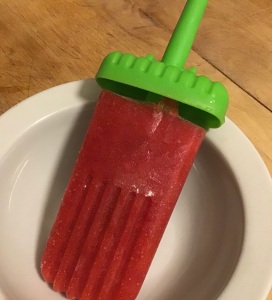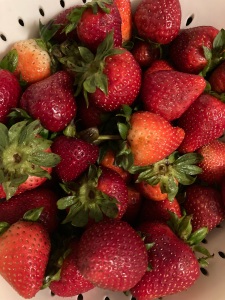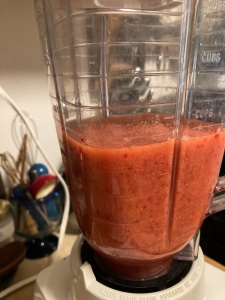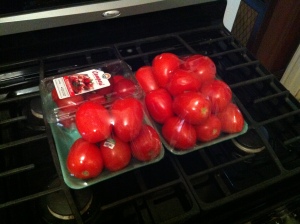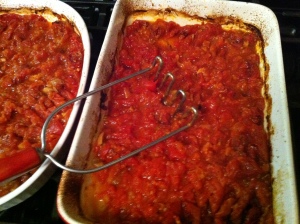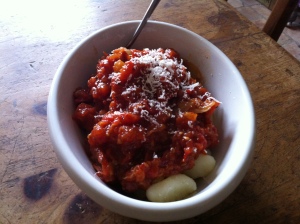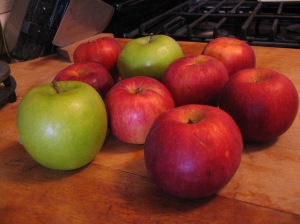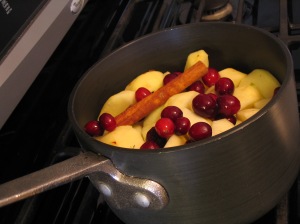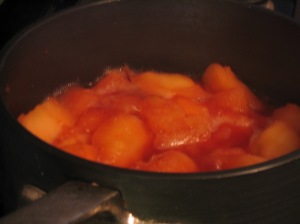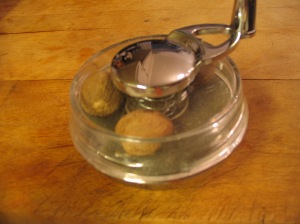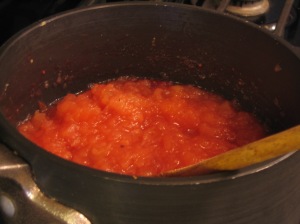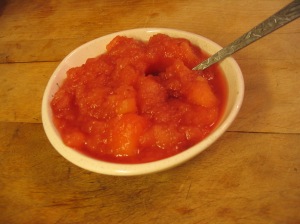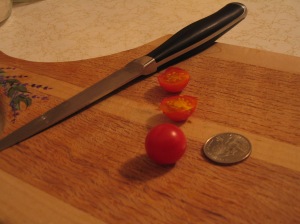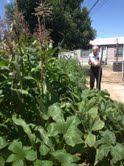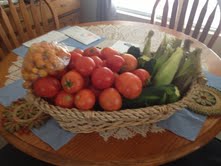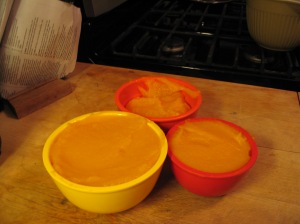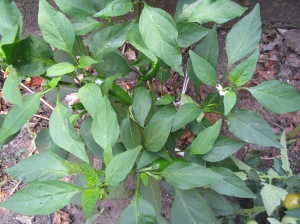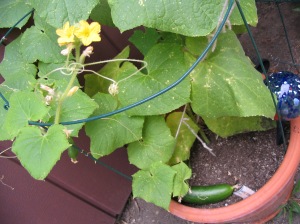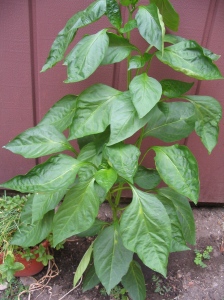Category Archives: produce
Frozen Fruit Bars
How to turn fresh fruit into summertime treats
With unprecedented heatwaves hitting much of the United States this summer, it seems everyone is looking for a fun way to cool off. Popsicles are great, but a lot of store-bought varieties are full of sugar. And the healthier ones made with real fruit can be expensive.
The good news? If you have fruit, a blender, a freezer—and some type of mold—you can make them at home.
Simple to make, refreshing, and healthy. What’s not to love?
The other day I saw these gorgeous strawberries on sale, just $2.50 for two pounds. With (another) string of 90+ days in the forecast, I knew I’d be making strawberry frozen fruit bars this week.
First, I soaked the berries about 5 minutes in cold water with a splash of cider vinegar. After rinsing and draining, I hulled and halved maybe two-thirds and popped them into a blender with about a quarter cup of water and hit puree for approximately 10 seconds.
At this point, sample the puree to see how sweet or tart it is. Tart berries might need a touch of honey, sugar, or agave, but don’t overdo it. Most of these berries were so perfect I only needed to add two scant teaspoons of sugar to balance the flavor. To add a little texture to the end product, I popped four more halved berries in and pulsed the blender two or three times.
Knowing how much liquid your molds hold is really helpful. From past experience, I know each of my six molds holds half a cup. The measuring lines on my ancient blender make it easy to eyeball the 3-cup mark. I could have added a few more berries and been just fine, but the fact is I wanted a few of those beauties to eat.
I carefully filled each mold directly from the blender’s pitcher. As you can see above, I could have made a tiny bit more. But I’d rather slightly under fill the molds than have the fruit mixture spill down the sides. I topped them off and popped them in the freezer. They take about 6 hours to freeze, but I usually leave mine in overnight.
If you decide to make frozen fruit pops, think beyond strawberries. Watermelon with a dash of fresh lime juice makes a great combination.
When I don’t have enough mixture to fill all six molds, I’ll juice a few oranges to fill the rest. I happen to have about a 10 clementines sitting in the fruit bowl. Once a couple of these molds are free, I’ll get squeezing.
Which fruits do you think make the best frozen fruit pops?
Simmering Stock
My love of making something out of virtually nothing isn’t new. It was already well-ingrained in me by high school when my Botany teacher explained how you can turn old bits of vegetables into soup stock and still have something left for the compost heap.
That’s when I started saving and freezing scraps. I put some onion skins and tomato cores in a gallon-size zip bag and popped it in the freezer. Every time I used fresh vegetables, I’d add any trimmings or peels to that bag. Over the course of a few months it began to grow. My dad noticed and asked why there was garbage in the freezer. “It’s for vegetable stock,” I said. That’s when he started calling it Garbage Soup.
Not the most appetizing label. But it is made of random bits of produce that would otherwise have wound up in the trash.
I still save scraps. And when the bag is full, I simmer up some savory stock.
I wish I’d thought to take a photo of the over-stuffed zip bag of random vegetable bits, but I didn’t think about it until I’d popped everything into a stockpot and covered it with water.
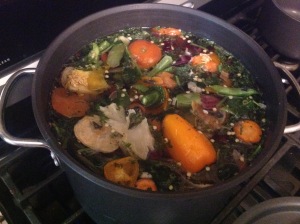
You can see there are bits and pieces of all kinds of vegetables, including one of those bite-sized sweet peppers that was starting to wilt. Not fresh enough for a salad, but fine for soup stock.
I simply empty my frozen veggie scraps into a 6-quart stockpot and top it off with water. I typically toss in a few peppercorns and a bay leaf and turn the heat up to high. It can take a while for the water to heat up, but thawing the veggie bits overnight in the refrigerator speeds it up a little. Just before it begins to boil, I reduce the heat to simmer and partially cover the stockpot, then simmer for about 30-45 minutes, until the largest vegetable bits are good and tender. If you want to salt your stock, wait until it’s finished cooking.

Next, I use a large slotted spoon or “spider” to remove the veggie bits from the pot and into a colander placed over a large bowl to collect any runoff, which I pour back into the stockpot.
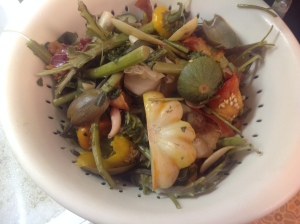
After that, I ladle or pour the stock through a finer sieve and into a bowl to trap pesky pepper seeds and tiny leaves. Ideally, I’d line the sieve with a layer or two of cheesecloth to reduce the amount of sediment in the stock, but I discovered I was out of cheesecloth.

I wound up with about 4 quarts of gorgeous, healthful, and flavorful vegetable stock. Here’s a peek at the final result:
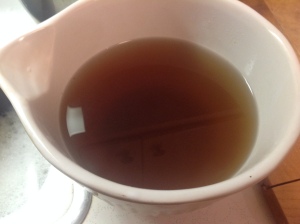
I cool it in the refrigerator overnight, then freeze the stock in 1-cup, 2-cup or even 1-quart containers. You could freeze it in ice-cube trays it you like.
My favorite way to use the stock is in vegetarian risotto, but I also add it to cream-based soups or use it in recipes calling for chicken or beef stock.
You can make stock from just about any vegetable trimmings you want. That said, I’d advise against adding too much of any strongly-flavored things. One year I tossed in a few too many dried up bits of fresh ginger root, another year, too many tough asparagus ends. (I was able to mix that broth with a different batch to even out the flavors a bit.)
Here’s a fairly comprehensive list of what went into this year’s broth: kale, spinach, sweet peppers, stem ends of a couple hot peppers, asparagus, cauliflower, broccoli, turnip, red and yellow onions, garlic, tomato, green beans, snow peas, zucchini, green and red cabbage, summer squash, celery, carrots, scallions, swiss chard, ginger, parsley, and butternut squash. This year I even found a few artichoke leaves and the leftover ends of a couple potatoes that I’d grated.
Leeks are a good addition, as are parsnips, corn, and beets—but go easy on the beets unless you want really red stock. Lettuce, mushrooms, eggplant, and cucumbers don’t add much to the party, but sometimes I’ll toss those in, too.
Homemade vegetable stock is a great way to use scraps you’d normally discard, like the tough stems from cauliflower and broccoli, seed cores from sweet peppers, dried ends of celery, and the crowns of root vegetables.
Less than an hour after making this year’s vegetable stock, my new zip bag was already starting to fill up.
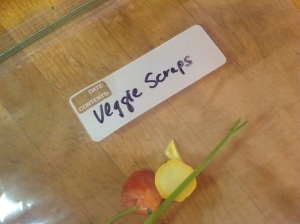
Apples to Apple(sauce)
Whenever my dad bought apples he managed to choose the bag containing the largest number of bruised apples. It didn’t matter what variety he chose, what season it was, or whether they were on sale or full price. They were always bruised.
No one likes biting into bruised fruit. That’s why people turn old bananas into banana bread, and why I turned this lot of mismatched, slightly past-their-prime apples into applesauce.
Perhaps best of all, it’s a lot easier than baking banana bread.
I started by peeling, coring, and quartering about two pounds of apples. (If they were fresher I would have left the skins on.)
I put the apples in a medium sauce pan with:
- approximately 1/3 cup of water (apple cider or apple juice would work, too)
- roughly one tablespoon of lemon juice (the amount depends on the varieties of apples you’re using and how tart you like your applesauce)
- one cinnamon stick (you can substitute about 1/2 teaspoon ground cinnamon if you don’t have a cinnamon stick)
- about 1/2 cup fresh or frozen cranberries (optional)
Start it on medium heat, and when it begins to simmer reduce heat to low or medium-low. Cover, but stir every couple of minutes. Simmer 20-25 minutes. Timing depends on how large the apple chunks are and which varieties are used.
The cool thing about adding cranberries? They pop when cooked, which turns the applesauce pink.
Once the apples are tender it’s time to mash them up a bit with a spoon and taste the sauce.
You might want to add a little sugar, a lot of sugar, some honey, or no sweetener at all. You can also add dried ground ginger, nutmeg, even a dash of vanilla if you like. I added:
- 1/4 teaspoon dried ground ginger
- about 1/3 cup of sugar
- a few grinds of freshly ground nutmeg (a little nutmeg goes a long way)
Quick aside: I was never a nutmeg fan until I got this cool nutmeg grinder for Christmas.
The types of apples you use — and whether or not you add cranberries — will make a big difference in what you decide to add. That’s why tasting is so important. If it’s too tart, add a small amount of sugar or honey and taste. Repeat until you like the flavor.
If you add sugar or honey, continue to simmer another minute or two so it cooks in. Remove the cinnamon stick.
I like chunky applesauce so I used a wooden spoon to break up the apples. Potato mashers also work well, especially if you prefer smoother sauce.
All that’s left is to dish up a nice bowl of fresh, homemade apple sauce and enjoy. It’s perfect warm or cold!
What’s My Garden Growing: Gajo De Melon
Last week I showed you the gorgeous Violet Jasper tomatoes growing in a garden pot out back. This week I have a couple of ripe Gajo de Melon heirloom tomatoes freshly picked from a plant just 20 feet away from the Violet Jaspers.
The Gajo de Melon plant really didn’t grow much. It had some yellow leaves early on so I removed those. I always water my tomatoes from the bottom, but this is the only tomato plant I have that isn’t at least partially protected by an overhang – maybe it isn’t doing as well as the others because its leaves get too wet when it rains. The poor plant looks half dead but it keeps blossoming and has already produced several tiny fruits.
I was expecting cherry tomato sized fruits, but this is what I got:
Yep. That’s a quarter next to the tiny beauties.
Despite the tiny size, they’re perfectly formed tomatoes that offer an intense, concentrated, slightly tart tomato flavor. They’d pair really well with bitter greens.
Now if you want to see a real garden bounty, Bonnie from Arizona shared these photos from her dad’s garden.
Now that’s a real home garden! Is everyone else as envious as I am about that yield?
Homemade pumpkin puree
I loathe pumpkin pie, but that doesn’t mean I hate pumpkin.
Pumpkin bread, pumpkin bars, pumpkin cookies. All good. It’s the slimy texture of pumpkin pie that I can’t stand.
You might remember this cute little pie pumpkin that adorned my dining room table this fall.
I kept it out through Thanksgiving. As long as the skin isn’t damaged, pumpkins will last a long time. Once the Christmas decorations went up, my intention was to cook and puree the pumpkin and freeze it for future use. I was a bit busy making Christmas gifts, so I didn’t get around to it until now.
Here’s how simple it is to turn your decorative pie pumpkin into a healthy puree ready to use in your favorite pumpkin recipes. (This works with pretty much any type of winter squash, too.)
- Wash the pumpkin.
- Remove stem and cut pumpkin into quarters.

- Remove seeds (you can save those to roast) and cut pumpkin into large chunks.
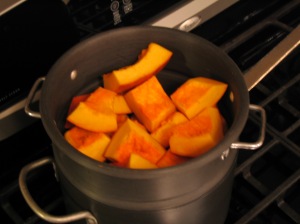
- Steam for about 15 minutes or until easily pierced with a fork. (Roasting is another option.)
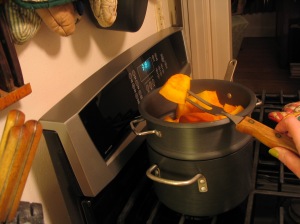
- Cool slightly and remove skin.
- Puree in food processor or blender until smooth. Add a little water if the machine seems to struggle to start processing. I added about 1/4 cup of water to this batch.
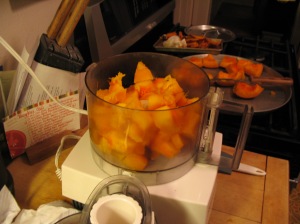

Since I’m not always sure what I’ll use the pumpkin for, I measure it out before freezing.
This pumpkin yielded roughly 4 cups of puree (the yellow dish holds 2 cups, the red one holds 1 cup and the bowl in back holds 1-1/2 cups when full) .
The recipe I’ll be making calls for 2-3 cups of pumpkin, so I’ll freeze the remainder for future use. When freezing puree, I always note on the container the date it was made and how much there is.
Care to guess what I plan to make with my pumpkin puree? One hint: It won’t be pumpkin pie!
What’s your favorite pumpkin-flavored food?
Volunteer Tomatoes
While weeding my little produce patches earlier this summer I spotted what looked liked tomato leaves popping up near where last summer’s cherry tomato plant grew. I decided to leave it alone and see what happened.
Soon it grew taller and sprouted more leaves. A couple weeks ago it began to blossom. The other day I spotted the first of several tiny green cherry tomatoes beginning to form.
It’s already Labor Day, so who knows if any of these volunteers will ripen before the first hard frost, but that really doesn’t matter since I can always add them to my annual batch of homemade green tomato salsa!
Happy Labor Day, everyone! (And yes, I’ll be laboring a bit today….no such thing as a paid holiday when you’re a freelancer.)
Pick A Peck of Peppers
Okay, so it’s not exactly a peck of peppers, but my one little jalapeno plant has been producing like crazy. I’ve already picked five peppers, and look how many are ready, or almost ready to pick.
(Immediately after taking the photo, I picked four more peppers.)
The first cucumber is ready for picking, and a smaller one is growing a bit higher on the vine.
The cucumber plant is loaded with blossoms, but so far just two cukes. They grow quickly, so I’m hoping for more.
I’ve already mentioned how well the tomato plants are doing – I’ve already lost track of how many tomatoes I’ve picked, and those plants are still loaded. The only plant I’m concerned about is the red pepper plant.
It’s beautiful, but I haven’t seen a single blossom. Any idea why it’s not blooming? Last year’s red pepper plant did so well that it wasn’t until a month or two ago that I finally finished up the leftover red peppers I chopped and froze last fall.
How are your gardens growing? Which crops are doing best for you this year?
